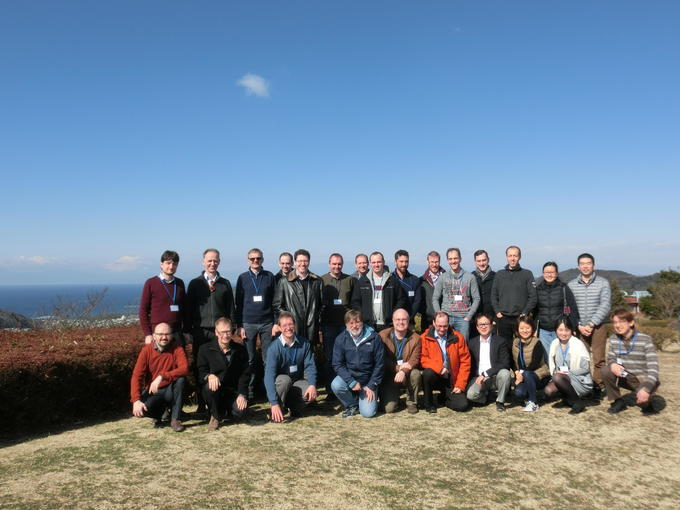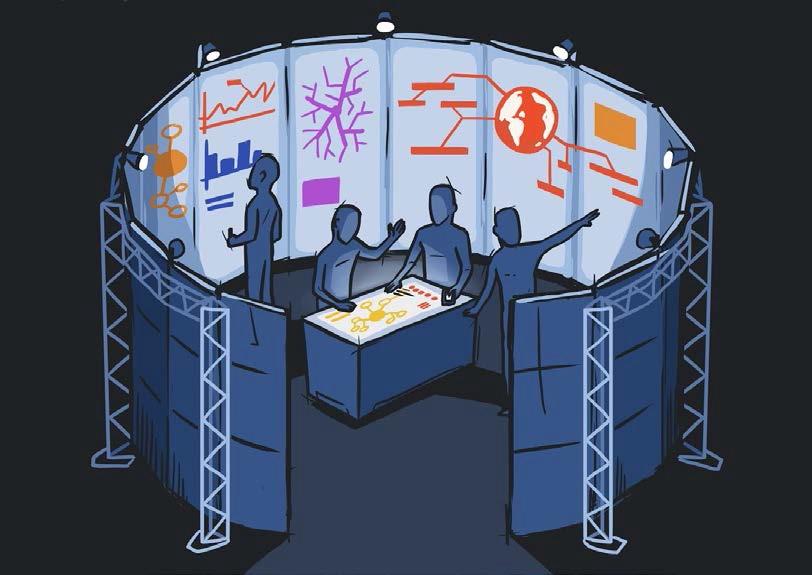NO.074 Immersive Analytics: A new multidisciplinary initiative to explore future interaction technologies for data analytics
February 15 - 18, 2016 (Check-in: February 14, 2016 )
Organizers
- Takayuki Itoh
- Ochanomizu University, Japan
- Kim Marriott
- Monash University, Australia
- Falk Schreiber
- Monash University, Australia
- Uwe Wössner
- HLRS Stuttgart, Germany

Overview
Description of the meeting
1 Introduction
There is a tidal wave of big and complex data across many domains. Several research directions are concerned with the development of methods to support the analysis of such data, including machine learning, information and data visualisation, data analytics and human computer interaction. However, there is still a major gap to fill: how can we immerse analysts in the data in order to provide more natural ways for data exploration, data analysis and collaboration?
In recent years we have seen significant advances in the development of new technologies for human-computer interfaces. Immersive environments like a CAVE make use of ultra-high resolution technology, and combine 2D and 3D visualisations to allow users to immerse themselves into computer generated scenes, e.g., in the virtual reality created in a flight simulator. Driven by the entertainment industry, tools and methods like voice- and gesture-based control as well as 3D VR and AR visualisation are becoming more and more part of everyday life. This has meant that technologies for natural user interfaces, virtual and augmented reality devices have progressed very quickly to provide very engaging and immersive experiences, and they are rapidly becoming available and affordable for small businesses and the general public.
In response to these new technologies, we propose a new facet of data analytics research that we call “Immersive Analytics”. This new research direction explores how these new display and interaction technologies can be used to create more engaging experiences and seamless work-flows for data analysis applications. The environments we envision that will be developed by immersive analytics researchers should be usable by experts and analysts to help in the detailed analysis of complex data sets, but will also be accessible to decision makers, that is, the managers who spend more time working face-to-face than in front of a desktop computer, and to the everyday public to help them in tasks like balancing nutrition, social and ethical concerns and price when buying groceries.
The ability to move inside the data with new display devices, to interact with the data representation in various direct and embodied ways allows the user to create a richer experience that may lead to better understanding and finally deeper insight. For that to happen, the visualisation and interaction concepts need to allow a faithful representation of the data and provide intuitive and efficient orientation and navigation in the data space. We expect that to create productive tools many gaps will need to be filled.

Figure 1: “Immersing people in their data” does not necessarily involve 3D or stereo display. In this concept, analysts work in a purpose-built, collaborative data analytics room. Interaction technologies like pen, touch and gesture control allow them to interact directly with their data and collaborate in a more egalitarian way than keyboards and mice, which tether individual users to a desktop. Immersive Analytics will systematically research how many kinds of emerging interaction technologies can be harnessed to engage and enable people to work together to better understand data.
2 Topics and Aims of the Meeting
Immersive analytics is inherently multi-disciplinary and involves researchers from human computer interaction, data sciences, visual analytics, augmented reality, data and information visualisation. Immersive environments for the analysis of complex data sets can be used on several levels including fundamental research, e.g., in application areas like biology, information security, or social sciences. We will bring together experts in these fields to define the new research direction by clarifying the major research challenges, potential approaches and identifying potential applications. Based on these we will compile a survey and manifesto defining the topic. We would ideally aim for this to be published as a book or special journal issue.
The overarching goal of immersive analytics research is to understand how (and whether) new interface and display technologies can be used to create a more immersive kind of data analysis and exploration. The kinds of devices and environments include augmented and virtual reality displays, large high-resolution 2D and 3D displays, haptic and audio feedback, and gesture and touch controlled interaction. These potentially require very different interaction and visualisation models and techniques to those used in standard visual analytics.
Some of the main research questions are:
- Much research has been devoted to computer-assisted collaboration both synchronous and asynchronous and local and remote. These new devices and environments potentially support new models for collaboration as shown in Figure 1. What paradigms are potentially enabled by these new interaction modalities? How do we evaluate them?
- Traditionally 3D visualisation has been used in the physical sciences, engineering and design; while 2D visualisations have been used to display statistical and abstract data in information visualisations. Increasingly there is a need to combine both sorts of visualisation in holistic visualisations. For instance in the life sciences different aspects of a cell are displayed using 2D and 3D images, 2D network data and the various -omics. Can these new technologies support more holistic visualisations of such data incorporating 3D spatial information as well as abstract data?
- What questions do technologies like augmented reality raise significantly for data and visual analytics? For instance, traditional information visualization supports open-ended exploration based on Shneiderman’s information mantra: overview first, zoom and filter, then details on demand. In our view a different model is required for analytical applications grounded in the physical world. In this case objects in the physical environment provides the immediate and primary focus and so the natural model is to provide detailed information about these objects and only provide contextual information on demand.
- What are the interface “tricks” and affordances such as high-resolution displays, sound, touch, responsive interaction that change the user perception from an allocentric view of the data to a more egocentric and immersive view of the data?
- What are the lessons that can be learnt from previous research into the use of 3D visualization for information visualisation? Do the new technologies invalidate the current wisdom that it is better to use 2D visualisation for abstract data since the designer of the visualisation has complete freedom to map data to an occlusion free 2D display?
- What are the most fertile application areas for immersive analytics? For example, these could be in life-sciences, disaster and emergency management, archaeology, and many more. What are domain-specific requirements, what are general requirements?
- How do we develop generic platforms that support immersive analytics? Currently there is a wide range of different development platforms and existing cross-platform tools however they do not quite have a broad enough focus for immersive analytics. For example, Unity is designed for gaming applications rather than analytics while the Visualization Toolkit (VTK) is targeted at scientific visualisation applications.
With that in mind, the aims of the Shonan meeting are as follows:
- To create a community of researchers into immersive analytics. To do so we will bring together experts from the human computer interaction, information visualisation, augmented reality and visual analytics communities from Europe, Asia, the Americas, Oceania; as well as domain experts from application areas that require analysis of complex data sets.
- To prepare the compilation of an Immersive Analytics manifesto that includes a definition and detailed description of this new research direction, and defines and documents the main research challenges.
- To investigate the potential and the challenges of immersive analytics for research and commercial applications.
- To investigate how existing interaction models and techniques can be adapted to the new environments, and where completely new approaches are necessary. Based on this to formulate guidelines for the use of such interaction models and techniques in immersive analytics.
- Initial design of open-source tools and generic platforms for supporting immersive analytics research and applications.
- To investigate how the evaluation of new concepts can be done, including interaction efficiency.
- To explore the design space for immersive analytics for effective collaborative data analysis in various forms, e.g., distributed or local, synchronous or asynchronous.
As a major outcome we expect a special issue of a journal or a book publication on Immersive Analytics.
